Everything you need to know about IP addresses
An Internet Protocol (IP) address is a numerical label that uniquely identifies every device that connects to the internet. It is used to:
- Identify a device or network connected to the internet
- Route packets (containing data) so they can find a device or network that is connected to the internet
If your device connects directly to the internet, it has a public IP address that everyone else on the internet can see. Good examples of devices with public IP addresses are modems and cell phones that connect directly to the internet.
If your device connects to the internet via an intermediary gateway device, then it has a private IP address, and the rest of the world will see the IP of the gateway device.
- How IP addresses work
- Local area networks
- IP addresses vs. domain names
- IPv4 vs. IPv6
- Dynamic vs. static IP addresses
- What is my IP address?
- How do I hide or change my IP address?
- How to trace an IP address
- Frequently asked questions
How IP addresses work
Devices and networks connect to and interact with other devices on the internet using a set of standards and rules known as the Internet Protocol suite (also known as TCP/IP).
The internet protocol (IP) itself encapsulates data into packets that can be delivered from the source device to the intended destination, which is identified by its IP address in the packet headers(new window).
IP addresses are administered by the Internet Assigned Numbers Authority (IANA), which is a part of the Internet Corporation for Assigned Names and Numbers (ICANN), a US-based non-profit organization primarily concerned with maintaining the DNS system.
AINA allocates blocks of IP addresses to regional internet registries(new window) (RIRs) around the world, which then distribute them further among national and local internet registries, which, in turn, assign them to internet service providers (ISPs) within their geographic area of concern.
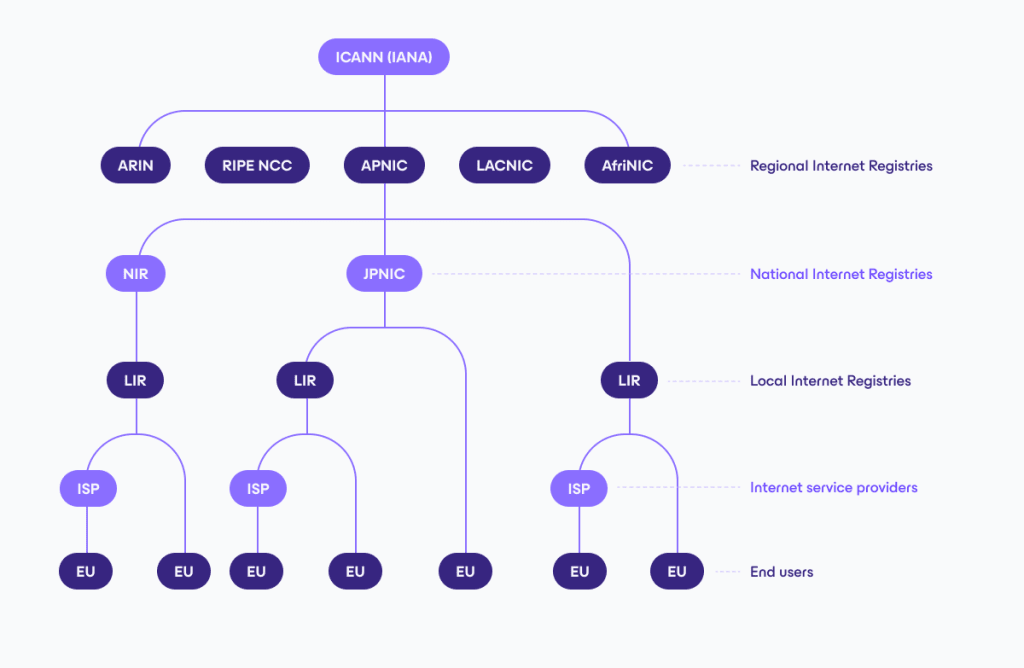
Domestic customers are assigned IP addresses out of the pool of IPs assigned to their ISP. Because ISPs usually assign blocks of IP addresses to the same geographic area, it is possible to make fairly accurate guesses about where a connection is originating from based on the IP address making the connection.
Most domestic IPs are dynamic, though, and are therefore subject to reassignment. So it is not possible to guarantee the accuracy of such guesses.
Local area networks
A local area network (LAN) consists of several devices that connect to the internet via a single portal. A good example is a typical household containing numerous phones, tablets, laptops, smart TVs, and other devices that connect to the internet via a modem (which is often also a router) supplied by your ISP.
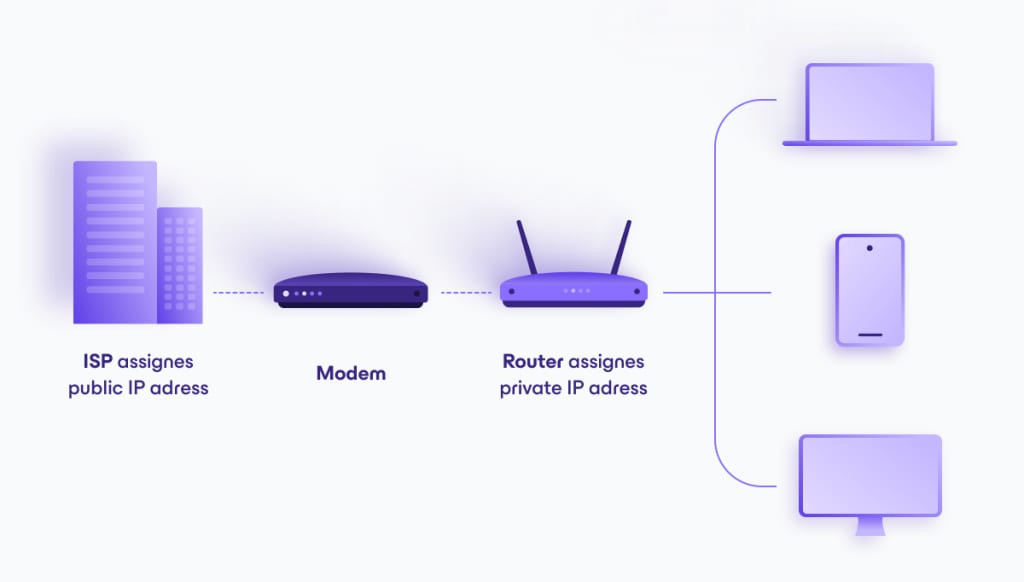
To the outside world, all devices on a local network have the same public IP address — that of the internet portal (e.g., the modem). Devices within the LAN are identified and addressed using private IP addresses that are managed by a router (which is often also a modem used to connect the LAN to the internet, but this is not always the case).
Large LANs are often organized into smaller subnetworks with their own subnet IP addresses.
IP addresses vs. domain names
IP addresses are numeric labels used by computers to identify other computers and networks, but they are not easy for humans to remember. So instead, we use domain names, which are alphanumeric addresses that map onto the IP addresses used by computers.
For example, the URL https://www.protonvpn.com(new window) currently maps to the IP address 185.159.159.142. If you enter 185.159.159.142 into your browser’s web address bar, it will take you to our website.
This mapping process is known as the Domain Name System (DNS), and it works very much like an address book, matching domain names with their corresponding IP addresses.
The domain name makes up part of the Uniform Resource Locator (URL), which also includes information on the protocol (such as HTTPS(new window)) used to connect to an internet resource and links to a particular file within a domain (such as a specific HTML web page).
IPv4 vs. IPv6
There are two versions of the Internet Protocol in common use today. The older Internet Protocol version 4 (IPv4) is still by far the most commonly used standard. It uses 32-bit internet addresses, which translates to 2^32 IP addresses available for assignment (about 4.29 billion total).
Unfortunately, thanks to the explosion of internet-capable devices that have become available over the last few years, these IPv4 addresses are running out(new window). In fact, strictly speaking, they have already run out(new window). Workarounds (such as reassigning blocks of IP addresses that are no longer in use) have allowed the system to limp on but are only postponing its inevitable demise.
The solution is to change over to the newer Internet Protocol version 6 (IPv6) standard. This uses 128-bit internet addresses, expanding the maximum available number of internet addresses to 2^128 (around 340 undecillion(new window)), which is a lot of IP addresses.
IPv6 addresses use the Hexadecimal Number System and look something like 2001:db8::8a2e:370:7334.
Unfortunately, upgrade costs, backward capability concerns, and sheer laziness mean that while most modern operating systems and network hardware supports IPv6, most websites and ISPs still don’t. The result is that entering 2022, only around 35%(new window) of internet users have access to IPv6, and only around 25%(new window) of Alexa 500 websites (a list maintained by Amazon of the 500 most popular websites on the internet) support the standard.
To help address this problem, IPv6 websites take a dual-tailored approach. If connected to over IPv6, they will accept the connection, but if not, they default to accepting IPv4 connections.
Dynamic vs. static IP addresses
A dynamic IP address can change, and these addresses make up the majority of domestic IP addresses. In practice, most ISPs do not rotate IP addresses very often, so your IP addresses may remain the same for years at a time. But this is not guaranteed.
A static IP address is guaranteed to remain the same. ISPs typically lease static IP addresses to businesses that need one. Typical reasons include running a corporate VPN that allows remote workers to access company resources, server hosting, improved reliability for VoIP communications, reliable geo-location needs, and so on.
What is my IP?
How to find your public IP address
You can easily see your public IP address by visiting our free secure IP scanner(new window).(new window)
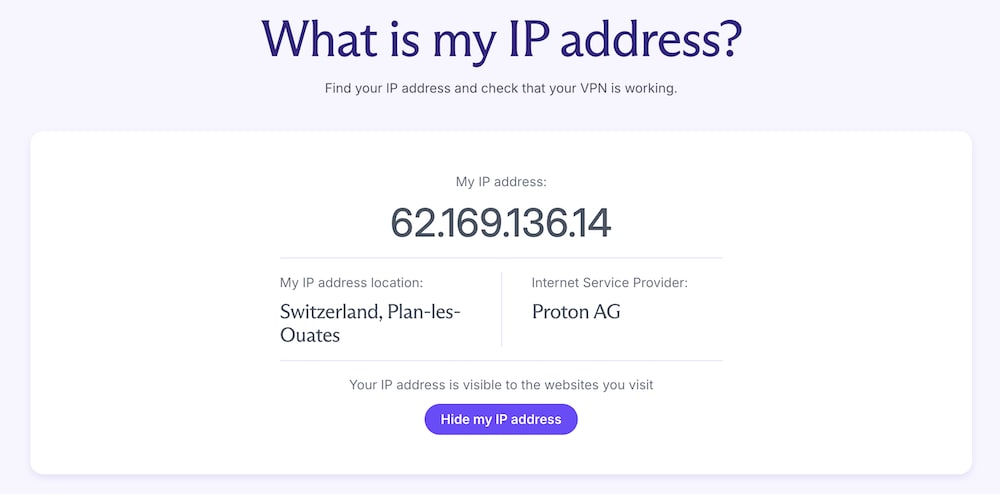
How to find your private IP address
You can easily find the private IP address of desktop computers on local area networks using your operating system’s command line.
Most current routers only support IPv4 addresses (usually looking like 192.169.x.x), although IPv6 routers are becoming available. If your router supports IPv6, you may also see an IPv6 address when you enter the following commands.
Windows 10 and Windows 11
1. Click Start and type powershell into the search box. When the app appears in the search results, Open it (Run as Administrator access is not required).
2. Type the following, then hit enter:
ipconfig
Look for your network interface (e.g., your Wi-Fi or Ethernet connection) → IPv4 address (and IPv6 address if supported by your router).
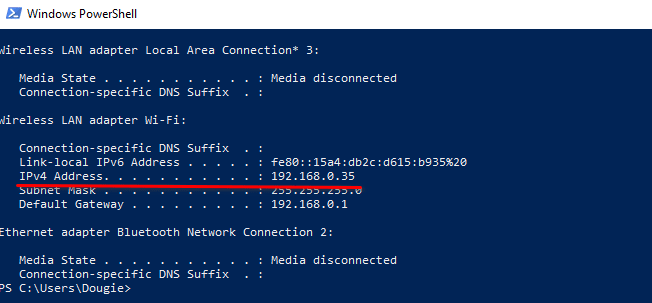
macOS
Open Terminal and enter:
ipconfig getidaddr en0

Linux
Open Terminal and enter:
hostname -I

How do I hide or change my IP address?
Your IP address is assigned to you by your ISP. Business customers may sometimes be able to purchase a static IP address from their ISP, but this is not usually possible for domestic customers.
However, it is easy to hide your IP address from others on the internet using a VPN. This routes your internet connection through a VPN server so that its IP address appears instead of yours when you connect to different websites and apps.
In addition to offering improved privacy when visiting websites, this also makes it easy to spoof your location, often allowing you to access streaming services such as Netflix as if you were in the country the VPN server is located in, so that you can access content you have subscribed to.
Learn more about VPNs(new window)
You can hide your IP address using a free VPN such as Proton VPN. With our Free plan, you can enjoy no-logs Swiss-based privacy with no data limits and no artificial speed limits. (Our latest security audit results confirm our no logs policy.) Upgrading to a paid Proton VPN plan will give you improved speed performance, access to many more VPN server locations, and a range of advanced features.
The Tor network(new window) also hides your real IP address in a similar way, but although an invaluable anonymity tool for those who need it, it is too slow for practical day-to-day use.
How to trace an IP address
You can easily discover the IP address belonging to any website using the command line on a desktop computer. Simply open CMD or PowerShell (Windows),Terminal (macOS or Linux), or Crosh (Chrome OS, using CTRL + ALT + T) and enter:
ping [domain name]
For example:
ping www.protonvpn.com
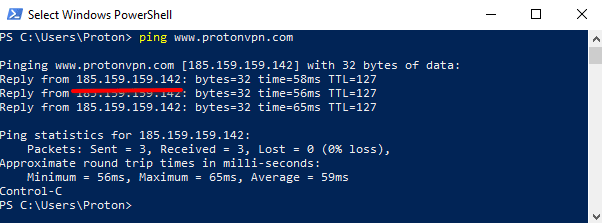
(Press Ctrl+C to stop sending packets to the target server.)
Final thoughts
Your IP address uniquely identifies you on the internet and provides websites and anything else you connect to a way to accurately guess your rough geographic location. To improve your privacy on the internet, you should therefore use a VPN to hide your real IP address.
Frequently asked questions
TCP stands for Transmission Control Protocol, and together with the Internet Protocol (IP), it makes up the Internet Protocol suite (often also known as TCP/IP). This suite of communication protocols allows computers to talk to each other on the internet.
Yes. Unless you take steps to hide your IP address, every resource you connect to on the internet can see your real unique IP address. This includes websites, email servers, game servers, and torrent peers.
If you are on a local area network that connects to the internet via a modem, the public IP address that everyone on the internet can see is the IP address of the modem, not your individual device.
The router assigns your device an internal-only IP so that it can route packets to that device on the local network. This is your private IP address.
Normally, only devices within the local area network can see your private IP address, although there are ways it can be exposed on the internet (via WebRTC, for example). This is not an issue, however, as your private IP address contains no personally identifiable information that might compromise your privacy on the internet.
The only way IPv6 is better is that there are many more IPv6 addresses to go around. IPv6 does not improve performance or offer any other advantages for end-users, a fact that has contributed to its slow uptake.







